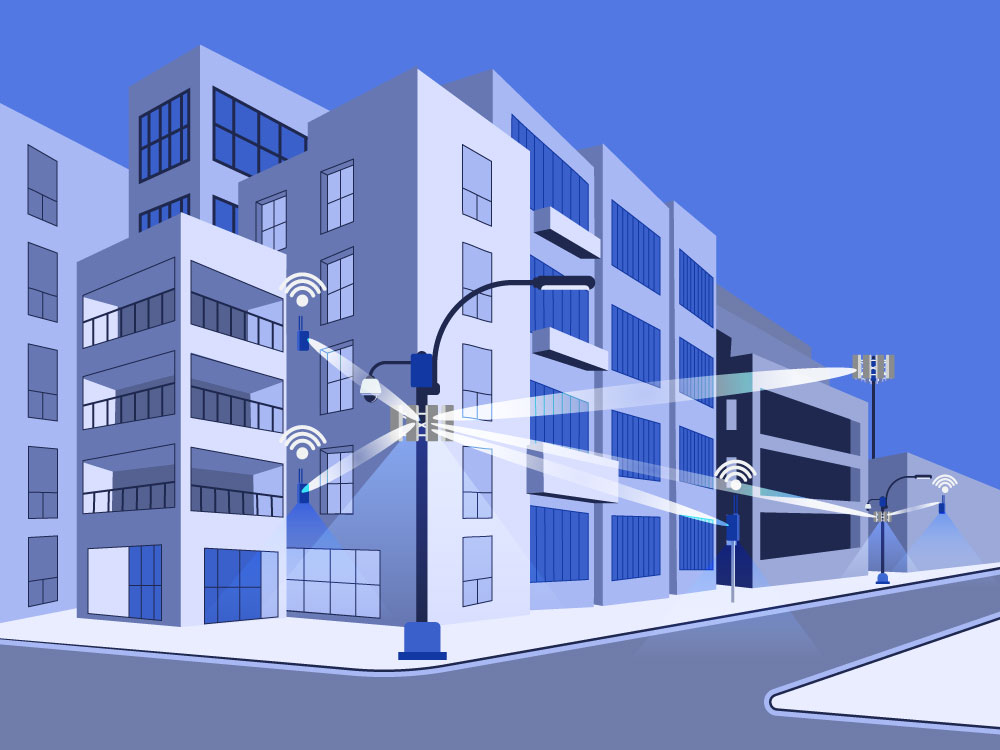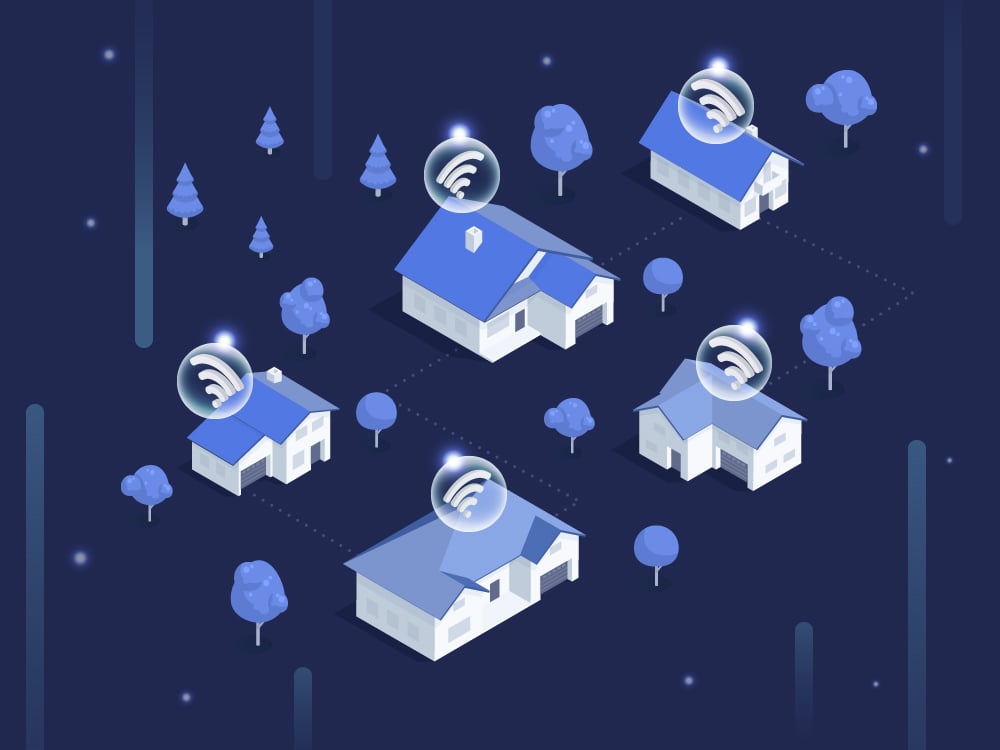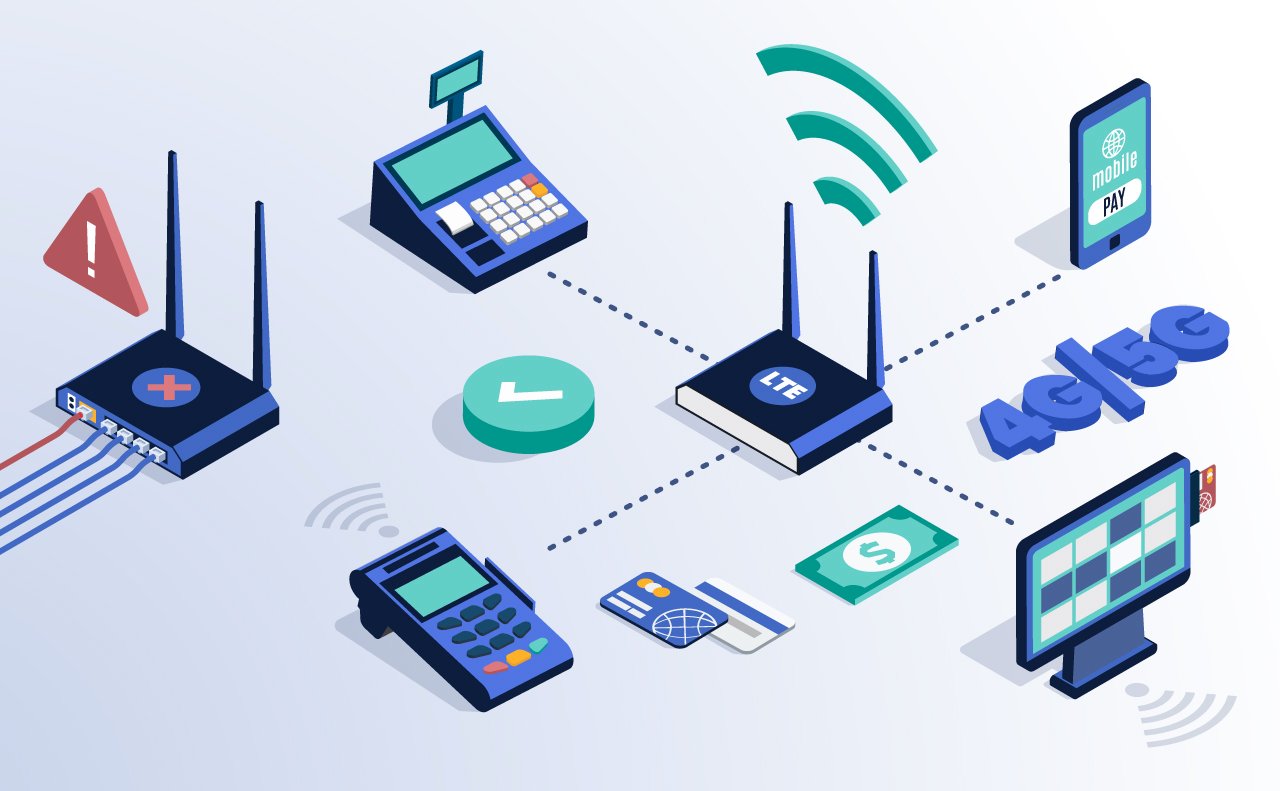Fixed Wireless:
A Viable Wireless Broadband Solution
for High-Speed Business Internet
by Ralph Heredia
Introduction
Fixed wireless as a form of cellular internet connectivity is not a new technology, but it is becoming more prevalent. Within the last year, more cellular carriers have turned to fixed wireless to bridge the digital divide and provide fixed wireless internet access to homeowners and businesses in remote locations. Additionally, small to mid-sized businesses are choosing fixed wireless broadband as a lower-cost form of high-speed Business Internet. Ericsson reports that in just 12 months, from October 2021 to October 2022, service providers offering 5G fixed wireless increased from 19% to 29%. The same report expects the number of fixed wireless connections to grow from 100 million in 2022 to over 300 million by 2028. Wells Fargo also forecasts that the fixed wireless subscribers will increase from the current estimate of 7.7 million to 17.5 million by 2027.
Given the recent predictions, you may be asking yourself
- Why is fixed wireless becoming preferable for Internet access?
- Is it truly a viable solution for businesses with high-speed data requirements?
- Is it a cost-effective form of Business Internet?
Fixed wireless access (FWA) has gained attention for two primary reasons–
- The cost, availability, and speeds of FWA are now comparable to wired networks, making it a reasonable and economical alternative to fixed broadband.
- 5G has expanded the opportunities for FWA. 4G LTE and 5G fixed wireless networks are complementary and both applicable for different use cases, but 5G brings faster speeds, reduced latency, and improved network capacity.
If you’re exploring the possibilities of FWA as a rural ISP looking to provide a competitive alternative to fixed broadband or a business leader seeking a cost-effective and secure cellular network, Zipit Wireless has over a decade of experience providing cellular connectivity and can help you connect your customers or devices with a reliable LTE or 5G FWA network. In this guide, we'll help you make sense of FWA by explaining how it works, its advantages over traditional wired broadband, and what you need to consider when evaluating FWA as a Business Internet solution for your company.
Key Takeaways
- Fixed wireless access (FWA) is a cost-effective solution to provide high-speed internet, especially in rural areas or areas where laying new fiber may be cost-prohibitive.
- FWA has an attractive investment profile for ISPs and MSPs, with lower capex risk and faster return on investment compared to fiber infrastructure.
- Deployment of FWA is efficient and quick, leveraging existing cellular infrastructure.
- FWA is suitable for various applications, including small to medium-sized businesses, large-scale temporary venues, remote work sites, and rural neighborhoods.
- FWA can also be used as a failover solution, providing backup connectivity when the primary internet connection fails.
- 5G technology enhances FWA capabilities, expanding its applications and reach to new customers.
- Zipit Wireless offers FWA data plans, subscription billing platforms, cellular carrier relationship management, and wireless hardware kits to support businesses in providing connectivity.
What is fixed wireless?
Fixed wireless is one form of cellular 4G LTE or 5G internet connectivity. As its name suggests, FWA provides wireless internet to a fixed location, which increases the efficiency of the connection compared to portable devices that require mobile broadband. Rather than supplying connectivity over a wired connection, FWA beams radio frequencies from a cellular tower directly to a home or business. With FWA, a service provider uses the existing cellular infrastructure (cell towers and base stations), so deploying the network is fast and inexpensive compared to laying new fiber. It enables service providers to offer homes and businesses wireless routers rather than cables, with the same quality of service.
Fixed wireless is a viable alternative to DSL, satellite, cables, and even fiber. For fixed wireless to compete with fiber internet, it must provide comparable internet quality and capacity since fiber connections typically allow unlimited data usage. The focused connectivity of FWA in conjunction with the high speeds and low latency of 5G makes it a scalable and cost-efficient form of high-speed broadband technology. 5G FWA is best suited for devices that regularly transfer a lot of data, but LTE continues to be useful for many less data-hungry applications.
"FWA is about replacing an Internet connection that previously came over a wire with a wireless cellular connection. In most cases, an FWA connection also implies high data usage."
– Frank Greer, Zipit Wireless CEO & Cofounder
How does fixed wireless work?
Fixed wireless provides internet connectivity transmitting wireless spectrum from a cell tower to a base station. The base station is the main connection point that transmits radio frequencies to antennas attached to routers in homes and businesses. In many cases, an FWA network configuration is point-to-multi-point, meaning that one central access point (the base station) is the source of connectivity for multiple subscriber locations. A fixed wireless subscriber’s home or business receives internet from an antenna affixed to a gateway (Wi-Fi router and modem) that provides internet to the various devices within a certain range from the base station.
Because it uses the existing cellular infrastructure, deployment of a fixed wireless network only requires connectivity through a cellular provider and a few customer premise equipment (CPE)– the Wi-Fi router, antenna, and modem.
Fixed wireless connectivity is always localized, but in some cases, homeowners may have FWA subscriptions and routers that allow them to move the router to a different fixed location and maintain connectivity. However, this type of “mobile” FWA does not guarantee a reliable connection. Fixed wireless is most advantageous and efficient for high-data use cases with stationary CPE receiving localized and focused spectrum.
Who is fixed wireless access for?
Fixed wireless to bridge the digital divide
Around half of the households in the world have access to wired broadband, and for those without, it’s not often feasible or affordable to build the wired infrastructure. Nonetheless, jobs, education, healthcare, and other necessities have become dependent on internet connectivity. Fixed wireless access is one solution to this crisis. Given the advances in wireless cellular technologies (new routers with MIMO antennas, new frequencies and spectrum bands, and backhaul improvements from the carriers), it is now possible to support higher speed and lower latency connectivity with wireless where it was not possible a few years ago. Fixed wireless is now a viable alternative to fixed wired deployments like cable and fiber.
Fixed wireless access for urban areas

In suburbs or rural towns, FWA can outperform and replace broadband options like DSL, satellite, and some cable connections. Households or businesses in these locations need high-data internet plans with speeds similar to fiber connections for streaming or connecting multiple devices. In cities, fixed wireless provides internet connectivity via small cells on streetlamps or other structures, and homes or businesses within range can connect using a router.
Fixed wireless access for enterprises

FWA can be a good source of internet connectivity for small to medium-sized businesses, with around 100 employees or fewer. With the growing demand and opportunities for connected devices, businesses of all sizes need reliable connectivity that meets these demands. For many businesses, fixed wireless can provide inexpensive, reliable, and secure internet. For larger enterprises, FWA can be a great failover source of internet.
Most small to medium-sized enterprises who deploy a wireless network want to maintain a level of control over the network and only allow certain devices to access the data. This is possible with a private wireless network with traffic routing and secure SIM cards that Zipit can provide your business. Contact us to discuss how we can help keep your network and devices secure.
Why is fixed wireless access pertinent?
1. The digital divide limits opportunities.
The world’s dependence on high-speed internet is growing. Jobs, education, and health are just three critical examples where an individual’s well-being depends on access to the internet. The gap in connectivity isolates communities and limits opportunities for the people that live in them.
Everything we do at Zipit Wireless revolves around building connections. By providing fixed wireless connectivity to rural ISPs, we hope to expand the opportunities for underserved communities. Learn how Zipit can help you connect your customers and devices.
2. FWA is getting faster with the mmWave.
The mmWave stands for a millimeter wave of spectrum that improves the performance and capacity of FWA networks and offers speeds that rival fiber internet. With mmWave, large campuses and venues can deploy fixed wireless networks for high-speed internet to a large number of devices or homes can enjoy online gaming with low latency. The downside of mmWave’s performance capabilities is its short range. But the new mmWave extended range functionality software expands the range from a maximum of 900 m to 5 km with high-power equipment and radios and a clear line-of-sight.
In 2021, Verizon paid $45 billion at auction for C-band frequencies from the Federal Communications Commission (FCC), which has allowed the MNO to expand its 5G Ultra Wideband Network, its fastest 5G offering. The C-band provides the optimal range and performance for 5G internet, and other MNOs, like T-Mobile and AT&T have taken advantage of the frequencies for 5G networks. Through our relationships with top MNOs around the world, Zipit offers fixed wireless internet connectivity that provides the same high speeds and capacities as internet service directly from Verizon or other MNOs.
3. The government is fueling connectivity.
The government is offering additional broadband and subsidies to close the digital divide. Government subsidies are needed in deep rural communities where network costs exceed the revenue potential. These subsidies include the Rural Digital Opportunity Fund (RDOF) with 20 billion dollars devoted to providing broadband in underserved communities, the Broad Broadband Equity, Access, and Deployment (BEAD) Program with 42 billion dollars provided to plan and deploy to expand high-speed internet access, and the Affordable Connectivity Program that offers a monthly discount on high-speed internet to low-income households.
4. FWA is becoming more affordable.
As more spectrum continues to become available, fixed wireless networks become more affordable. More high bands of spectrum have opened up to meet the growing demand for high-speed broadband for video streaming.
5. Demand for high-speed internet is increasing.
The demand for high-speed internet in homes and businesses for streaming or IoT devices is increasing, but the performance requirements are too high for DSL, cable, or satellite. FWA provides a source of additional revenue streams for ISPs.
Fixed wireless compared to other forms of broadband
Broadband is the all-encompassing term for different types of high-speed internet networks, including cellular, cable, DSL, satellite, and Wi-Fi. Fixed wireless complements pre-existing broadband networks to support a wide variety of use cases and internet needs. Here’s how FWA compares to other forms of broadband.

Fixed wireless broadband vs. fixed broadband
Fixed broadband includes xDSL, cable, and fiber internet provided through a wired connection. On the other hand, FWA is a form of wireless broadband and receives connectivity by radio frequencies transmitted from a cell tower to fixed antennas that are part of a router. Of the three fixed broadband types mentioned, fiber networks provide the highest internet speeds but are expensive to deploy. DSL and cable are often easier to deploy than fiber if there is a pre-existing telephone line or cable equipment, but they are slower. The quality of a DSL connection also depends on the proximity of the nearest phone company and how reliable their connections are.
How does FWA compare to fiber internet?
4G and 5G fixed wireless are faster than DSL and, in some cases, cable. It’s also less expensive and easier to deploy than fiber. With the mmWave, FWA can provide comparable internet speeds to fiber that are 10–15 times faster than 4G LTE FWA. Since FWA leverages the existing mobile infrastructure, uses spare spectrum already owned by mobile network operators (MNOs), and can be deployed offsite, it has a faster time to market than fiber. Alternatively, fiber has a lengthy and costly deployment process and must be deployed onsite. As fiber moves into rural areas, its ROI diminishes, so FWA is often more economical in these locations. For service providers, however, fixed wireless and fiber are both considered the future of fixed technologies, for different use cases.
“Wireless networks are no longer just used for mobile devices; they’re now fast enough and powerful enough to dedicate to a fixed location.”
– Ralph Heredia, Zipit Wireless VP and Cofounder
Fixed wireless vs. mobile broadband
Fixed wireless internet is localized, but mobile broadband (MBB) is portable. MBB is best used to provide connectivity for a single device on the go. FWA, on the other hand, provides high-speed internet access for all devices within a fixed range. Of the two technologies, fixed wireless is more efficient because it provides a single, direct source of connectivity, while performance with MBB internet declines (increased latency and slower speeds) when devices have to switch between networks as they move to different locations. FWA routers are also much more powerful and capable than MBB because of FWA’s MIMO antennas, higher-powered amplifiers, and faster chipsets that are not sensitive to battery applications.
Fixed wireless vs. satellite
Satellite is another solution for internet connectivity in rural areas, but it doesn’t have as many advantages as fixed wireless. Even under optimal conditions, satellite internet experiences increased latency and slower internet speed than FWA. Satellites transfer data from a home or business to the network hub and back again. This long travel time puts satellite internet at a performance disadvantage compared to an FWA connection, where radio frequencies only have to move a short distance. Satellite internet is also frequently disrupted by bad weather, including weather experienced in orbit but not on the ground. FWA is more tolerant of weather disruptions.
The cost of fixed wireless
As more spectrum is made available, fixed wireless becomes cheaper, and as cellular technologies advance, the cost of delivering gigabytes of data declines as capacity increases. Ericsson reports that “FWA providers can enter rural and urban markets at about one-tenth of the cost of laying physical fiber.” Many studies also demonstrate the cost savings for customers with FWA. Broad Band Communities magazine found that with 30% of households subscribing to FWA, the cost for rural connectivity was 2.5 times higher with fiber. Wells Fargo also found that fixed wireless can be 50% cheaper than some low-tier cable plans. For existing MNO customers, adding FWA to their home internet services costs approximately $25–$30 each month.
Whether or not FWA is economical for businesses varies by use case. For instance, a coffee shop in search of high-speed internet for customers and POS devices should consider fixed as a cheaper alternative to fiber. Installing dozens of FWA routers at a hospital would not be the most scalable or cost-effective primary source of internet, but it could be a good failover option.
Whether you need to provide FWA to rural customers or want to use it as a backup internet, we can provide you with competitively priced data plans for your fixed wireless network.
Learn more
Advantages of fixed wireless access
1. A viable solution for the growing demand for high-speed internet
The options for reaching unconnected customers in rural areas include laying new wired infrastructure, using another form of fixed broadband like satellite or DSL, or deploying a fixed wireless network. The first option is expensive and slow to market with the need to obtain permits to lay the fiber. The second option does not meet current or future high-speed internet requirements for streaming or work-from-home situations. Out of all of the existing options, fixed wireless is the most cost-effective solution that meets high-speed, low-latency internet needs.
2. An attractive investment profile
Building a fiber network infrastructure requires a high upfront investment that must be made up-front before anyone has signed up for the internet services. The more rural the location, the lower the return on investment because fewer customers can subscribe to the internet services. Fixed wireless, on the other hand, takes advantage of the spare spectrum capacity of existing infrastructure. It allows service providers to pack more services in the same frequencies without costing more in additional infrastructure or spectrum. The initial investment in FWA comes with lower risk and often results in payback after 1 year. Even if there aren’t many household FWA subscribers, the spectrum can be used for mobile service or IoT devices.
3. Efficient deployment & shorter time to market
A fixed wireless network can be deployed wherever cellular connectivity exists. It piggybacks on the existing mobile infrastructure, requiring only base stations or small cells and subscriber antennas and gateways. Deployment is fast, and many updates to the network can be made remotely. FWA provides ISPs with an efficient and future-proof way to expand their services to unconnected customers.
Zipit helps businesses accelerate their time-to-market for FWA offerings and rapidly deploy wireless solutions to their customers by providing all of the key pieces in one place–competitive rate plans, simplified end-user billing, and a single platform to manage connectivity across different carriers and regions.
Challenges with fixed wireless access
1. Scalability while meeting customer expectations
To reasonably present FWA as an alternative to fiber, it must meet customer expectations for internet performance and not lag behind fiber networks. Most fixed broadband customers are accustomed to the unlimited data model, which presents a challenge for FWA. Not only must FWA be able to support unlimited data use, but it must also be scalable as traffic to the network grows. A certain amount of spectrum is limited in how many users it can accommodate without compromising the quality of service. If the number of users on a network increases, the MNO must increase the spectrum, which is costly and not always available.
Solution: To ensure consistent quality during high load times, service providers must set a minimum data rate that a household can experience during peak traffic times. Experience has demonstrated that an unlimited traffic allowance does not clog the network and is manageable on average. Additionally, newly available spectrum has improved network speeds.
2. Maintaining consistent user experience across multiple connectivity points
Internet quality with FWA decreases the further customers are from the base station, and with spectrum shared between customers in a point-to-multipoint configuration, internet performance suffers as cell load increases during busy hours.
Solution: The combination of high-band mmWave technology and mid-band spectrum provides additional opportunities for distant households to receive reliable connectivity using mmWave in good conditions and mid-band in poor conditions. This solution also extends the revenue opportunities for ISPs.
3. Spectrum scarcity
An FWA network is fast to deploy, assuming spectrum is available. The demand for more bandwidth and network capacity has increased significantly within the last century, but the US government's use of spectrum hasn’t changed much. Within the last several years, the government has auctioned off more spectrum, but according to Forbes, the US still lags compared to other nations.
Solution: Mid and high-spectrum bands have recently opened up and been auctioned off, resulting in lower costs for access to the network. As more spectrum becomes accessible, the more competitive FWA will become. And the more FWA sites with access to 5G capacities, the more cost-efficient the data transfer will become.
Fixed wireless applications
Advancements in fixed wireless are exciting, but FWA is best suited for specific high-data usage scenarios. Here are a few instances where fixed wireless is a great fit.
1. FWA for small to medium-sized businesses

Fixed wireless provides speeds fast enough to supply internet access for SMEs with fewer than 100 employees. The larger the business, the more base stations, antennas, and routers that would be required, so fixed wireless internet reaches a point where it’s no longer practical for a large enterprise as the primary source of internet. SMEs that do deploy FWA networks can set up network traffic routing and control which devices that can access the network with private traffic routing.
If your business is interested in a private FWA network, Zipit can provide the connectivity needed to deploy the network and the software to manage billing and devices.
2. FWA for large-scale solutions
FWA is a good option for temporary venues that need high-speed internet to set up video, music, or digital signage for a brief length of time, before moving to a new location. Fixed wireless could also provide high-speed connectivity to stream music and videos on multiple TVs in supermarkets. Other large-scale FWA use cases include security cameras that need a lot of data to transfer images but don’t move from their fixed location.
3. FWA for remote work sites

For locations that only need internet connectivity for a temporary amount of time, like a construction zone that needs to communicate back to the main office, laying a cable or fiber infrastructure doesn’t make sense. FWA is the best alternative. And once the work is complete, the fixed wireless connectivity may be strong enough for the site owners to continue to use as a primary source of internet or for backup connectivity.
4. FWA for small commercial areas
Some cities may choose to deploy an FWA network to densify internet access in downtown hubs by installing small cells on street poles.
5. FWA for rural neighborhoods

An FWA network can be a smart investment for an entire neighborhood. Small cells can be installed on all street lamps in the neighborhood and each subscriber can access the FWA internet by subscribing and connecting to the network via a router with a built-in antenna. FWA is also a good source of internet for RVs parked in remote locations. RVs consume the most data when parked, and owners often need connectivity comparable to their home internet service.
If you’re an ISP or reseller looking to expand your services to unreached communities, we can help get you there by providing the FWA data plans and management platform so you help unreached customers get the connectivity they need while receiving quick payback on your investment.
6. FWA as a failover solution

Large organizations that would not likely use fixed wireless as their primary source of connectivity or even homeowners or businesses who already have access to fiber internet may still benefit from FWA as a failover option. Customers would pay a low monthly fee for fixed wireless failover that acts like an internet insurance policy. Should their primary internet fail, the FWA connection will kick in automatically.
5G and fixed wireless
Fixed wireless has been in existence for many years, but 5G allows FWA to expand its applications to serve more data-intensive use cases. 5G is expected to supply connectivity with 10–100 times the capacity and throughput rates of 4G. The 5G mmWave is the first form of cellular wireless connectivity with speeds that match fiber internet. 4G and 5G fixed wireless networks are each beneficial for different applications.
Zipit Wireless can provide high-data 4G and 5G fixed wireless plans to enable rural ISPs to expand their services and reach the unconnected. Contact us to partner with your business in providing connectivity.
What carriers offer fixed wireless access?
At this point, almost all MNOs provide 5G fixed wireless. AT&T began offering fixed wireless internet to rural communities in 2017. In 2018, Verizon installed a wireless antenna on the home of their first FWA customer in Houston so the homeowner could successfully work from home. Verizon installed nodes on street poles to transmit frequencies to their first customer’s antenna, as well as any other neighbors who would follow suit. US Cellular was the first provider to offer FWA with 5G extended-range mmWave and provide connectivity over 5 km. But as of 2022, T-Mobile was the largest single provider of 5G FWA services and is on track to grow from 984,000 FWA subscribers to 7–8 million by 2025.
Zipit maintains relationships with top cellular carriers to help you manage your connectivity easily. Connect with us to save you time in acquiring connectivity.
FWA with Zipit Wireless
Zipit Wireless is a team of experts on IoT and cellular connectivity, dedicated to enabling wireless expansion. Connecting people and devices is what we do best. So when we realized that many of our ISP partners needed to provide internet connectivity to rural homes and businesses, we decided to provide competitively priced 4G LTE and 5G fixed wireless data plans with a subscription billing platform to help bridge the gap in connectivity to unreached customers and enable service providers to extend their return on investment and expand their market reach.
Zipit Wireless can provide your business with
- FWA data plans, ranging from 4G to 5G ultrawide unlimited plans
- Subscription billing platform
- Cellular carrier relationship management
- Wireless hardware kits (routers, modems, SIM cards) through proven partners
We maintain relationships will major global carriers and manage all contracts so you can focus on getting your product or service to market or deploying connectivity faster. We also provide a customizable platform where you and your customers can manage data, devices, and billing in one simple location.
Even if fixed wireless isn’t the right solution for your services, we can help connect you with one that is. We would love to provide your business, customers, or devices with high-speed cellular internet so that you can achieve more efficient and profitable business processes, monetize your IoT products or services, or connect your rural customers with affordable, high-speed FWA internet. Contact us to learn more about how Zipit Wireless can partner with you to provide connectivity for your business.
Contributors:
Sources:
- Could Fixed Wireless Access Bridge the Digital Divide? (Broadband Communities Magazine, 2021)
- North America moves steadily towards wider 5G, FWA and IoT adoption (Telecom TV, 2022)
- Bridging the digital divide: Extended-range millimeter-wave 5G Fixed Wireless Access (Ericsson, 2022)
- Five Things About Fixed Wireless (FWA), The Future of Broadband (Forbes, 2022)
- How Fixed Wireless Technologies Compare to Fiber (Benton Institute for Broadband & Society, 2022)
- Fixed Wireless Access: An Economic Study (Ericsson, 2018)
- Fixed Wireless Access handbook: Extracted version, 2023 edition (Ericsson, 2023)
- The State of Broadband: People-Centred Approaches for Universal Broadband (Broadband Commission for Sustainable Development, 2021)
- Is Fixed Wireless Ready to Take on Cable? It’s Early But the Initial Data Seem Promising (Forbes, 2022)
- Ericsson Technology Review: Fixed Wireless Access in LTE and 5G (Ericsson, 2018)
Zipit Blog
The latest IoT insights and platform updates from Zipit.
Many IoT devices operate from fixed locations, quietly driving automation, data co...
As billions of connected devices continue to shape modern life, IoT manufacturers ...
The Internet of Things (IoT) is transforming how businesses operate, compete, and ...




